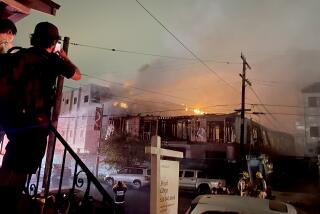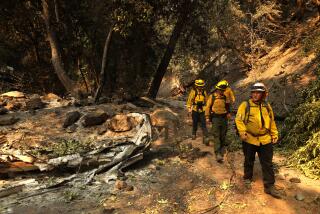San Gabriel Mission, a symbol of faith, history and oppression, is badly damaged by fire
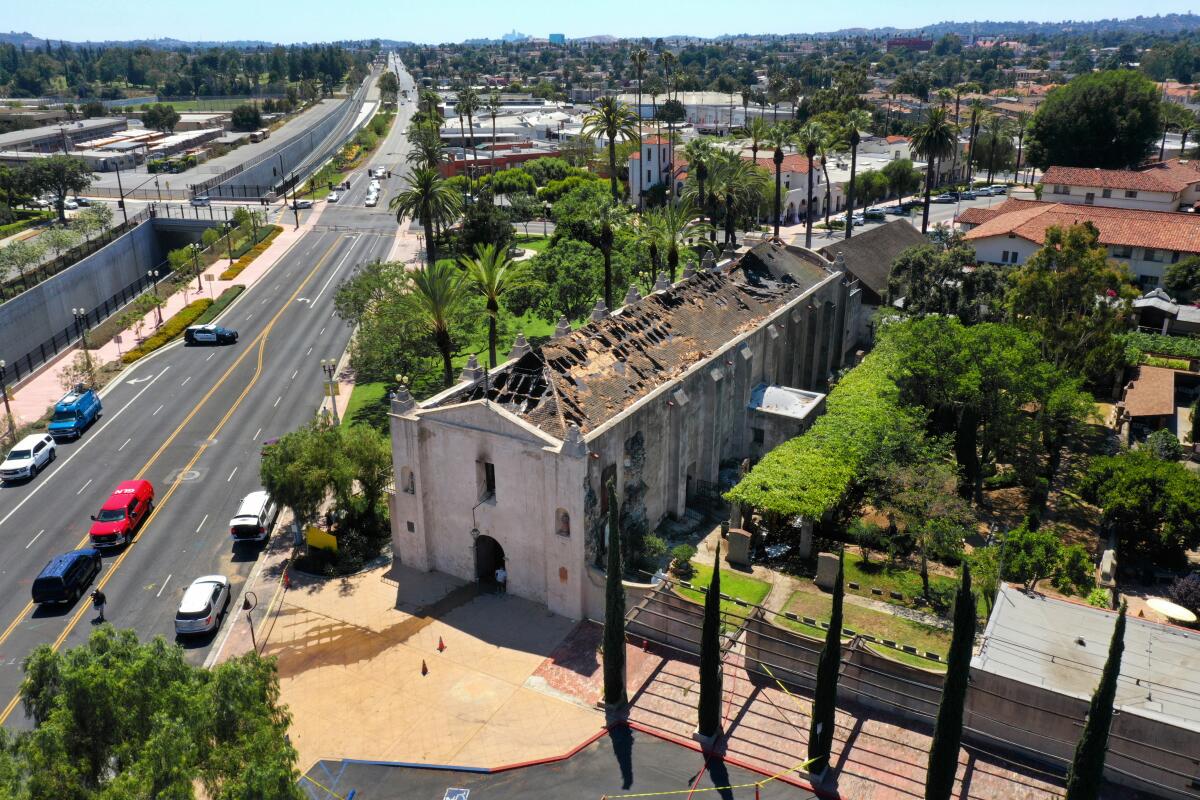
Anita Chavez joined the hundreds of mourners at San Gabriel Mission Church on Saturday for what many considered a family wake without a body.
They came from across the region to survey the destruction after a fire that ripped through the church of the 249-year-old mission, one of California’s most historic landmarks, sacred ground for the Catholic faithful but also a symbol of a system that enslaved and terrorized indigenous peoples.
Hundreds of parishioners from the San Gabriel Mission Roman Catholic community gathered all day in the parking lot to cry, grieve, pray, reminisce and talk about their faith.
‚ÄúMy heart is full of sadness,‚ÄĚ said Chavez, a 70-year-old San Gabriel resident who calls herself a ‚Äúlifetime parishioner.‚ÄĚ
‚ÄúThis church has been at the center of my family, my world and my faith,‚ÄĚ she added.
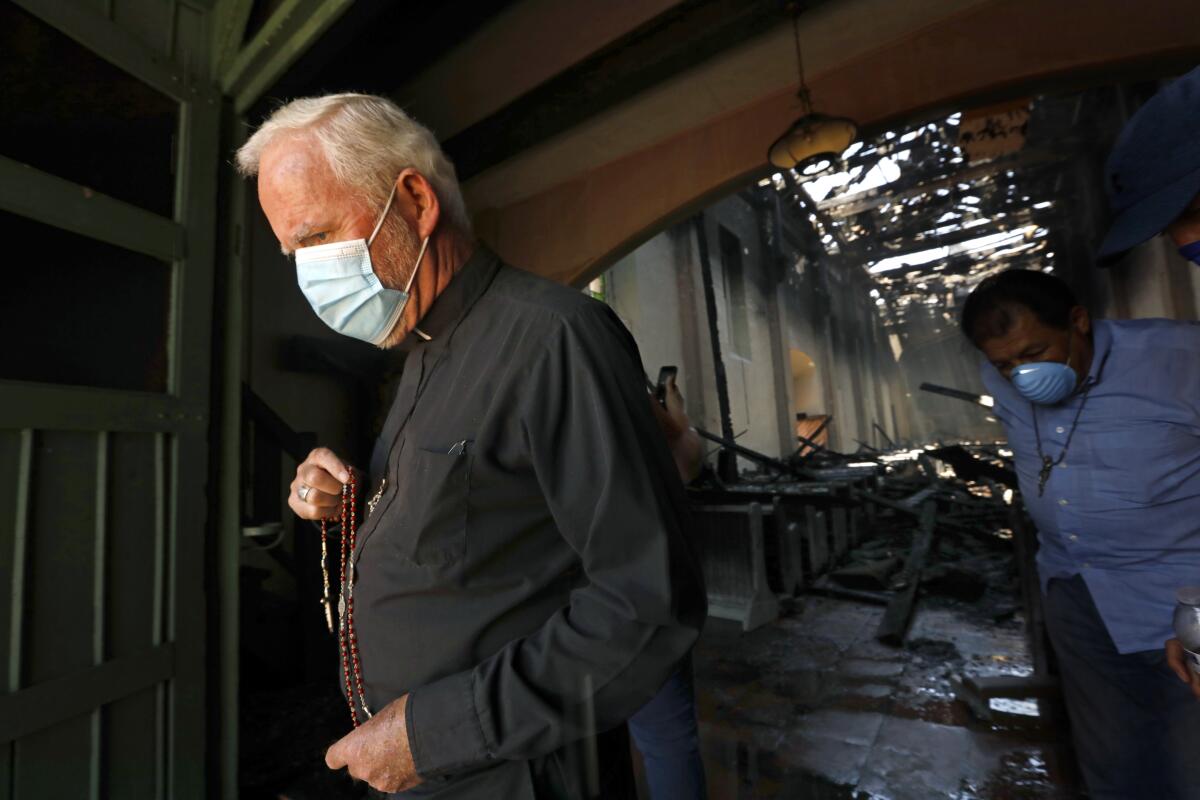
The fire was first reported at 4:24 a.m. When an engine arrived to investigate, firefighters saw flames and smoke coming from the corner of the mission.
Firefighters tried to save the church. But portions of the 215-year-old building started to fall on them and they decided to battle the fire from outside, said Capt. Antonio Negrete, public information officer for the San Gabriel Fire Department.
No injuries were reported, but the damage was extensive.
Flames destroyed the roof, most of the just-refurbished pews and portions of the interior, though some statues and other historic items survived.
Most valuable artifacts escaped damage, said Terri Huerta, director of development and communications for the mission.
‚ÄúThe altar is still intact, the last time that we were able to take a peek inside,‚ÄĚ she said. ‚ÄúIt‚Äôs miraculously intact, including the historical wooden statues that were attached to the altar, and so we have a lot to be grateful for.‚ÄĚ
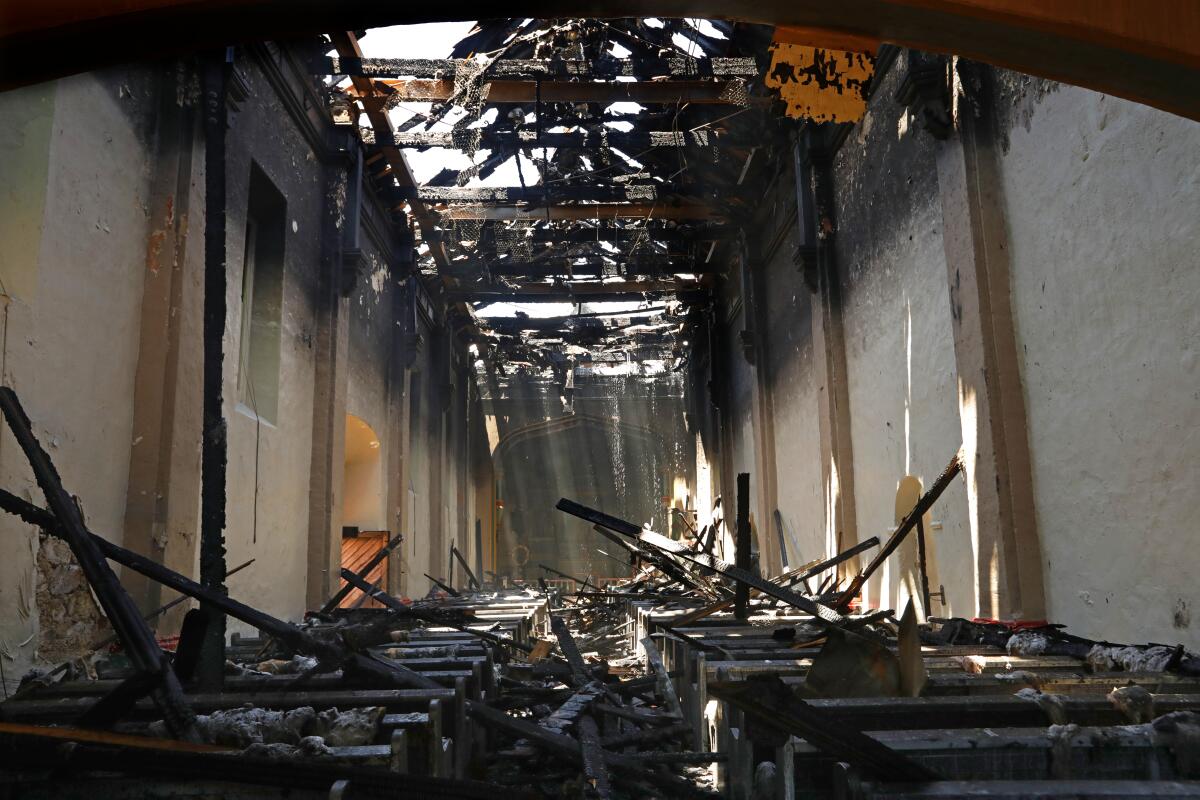
The cause of the fire is under investigation. The blaze came amid rising anger over California missions and other colonial monuments that for many serve as painful reminders of the nation’s racist history. For that reason, investigators, including a representative from the federal Bureau of Alcohol, Tobacco, Firearms and Explosives, were looking into whether it was intentionally set, officials said.
‚ÄúJust because it‚Äôs a church, and I‚Äôm sure you‚Äôre aware of the recent vandalism that‚Äôs been done to the mission churches and the statues of Jun√≠pero Serra,‚ÄĚ Negrete said. ‚ÄúSo that‚Äôs part of the investigation.‚ÄĚ
Founded by Franciscan Father Junípero Serra in 1771, the San Gabriel Mission has long been seen as an essential link to California’s past, as well as to the brutality and racism that played a role in the state’s founding.
Considered by historians to be the most important base of operations for the Spanish conquest of California, San Gabriel was the fourth of 21 missions established in the state, and one of the grandest. At its height in 1829, the mission had 50,000 livestock, 160,000 grapevines, and 2,300 fruit trees, said Philip Ethington, professor of history and political science and chair of the history department at USC.
But the church amassed those riches on the backs of the Tongva and other indigenous people, whom the friars forced into labor and coerced into converting to Catholicism and assimilating to their culture.
‚ÄúIt was really a labor camp enforced with whipping and stockades and lots of corporal punishment,‚ÄĚ Ethington said.
Thousands are estimated to have died after they were exposed to foreign diseases or suffered other ‚Äúcomorbidities of conquest,‚ÄĚ said William Deverell, director of the Huntington-USC Institute on California and the West and a professor of history at USC.
‚ÄúIt‚Äôs still a site of faith and worship, but it‚Äôs also a site of great sadness,‚ÄĚ Deverell said. ‚ÄúBecause in that parish ground, within the confines of the church, there are thousands of unnamed indigenous dead below what‚Äôs now a small Catholic cemetery.‚ÄĚ
Yve Chavez, an assistant professor at UC Santa Cruz, whose ancestors lived at the mission, helped build it and are buried in its cemetery, also described its legacy as complicated.
‚ÄúOn the one hand, the news of today is quite devastating because this is something that our ancestors made,‚ÄĚ she said. ‚ÄúSome people might see these as monuments to Catholicism or Spain, but I think it‚Äôs important to recognize that this is the product of Native labor.‚ÄĚ
Still, she noted, that work was performed under duress and came at an unspeakably high cost.
‚ÄúThe structure itself is a reminder of our ancestors who sacrificed their lives and their labor to make these missions possible,‚ÄĚ she said.
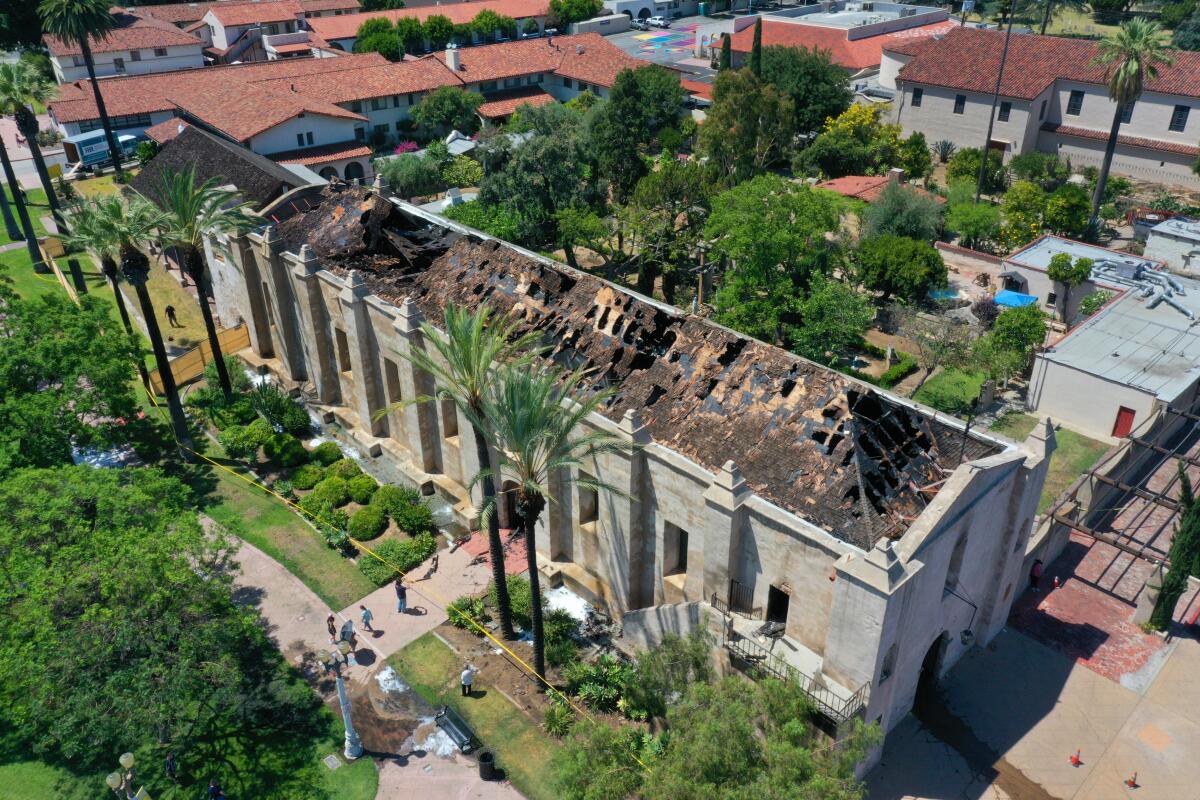
In addition to destroying the lives of Native Californians, the mission system has deeply tarnished the image of Serra, its architect, who has long been considered one of California’s founding fathers. Serra was made a saint by the Catholic Church in 2015, fueling outrage from many indigenous activists and others.
Statues of Serra have been targets of vandalism in recent years by activists who point to how the mission system enslaved and killed off Native Californians. Those protests grew in the wake of the police killing of George Floyd, which ignited a nationwide reckoning over racial justice. A Serra statue at Olvera Street was toppled, and officials in Ventura pledged to move a statue of Serra that stands outside City Hall.
The San Gabriel Mission also features a statue of Serra, and officials stepped up security around its grounds about two weeks ago, Huerta said. The mission eventually decided to move the statue into its garden, away from public view, she said.
Julie Sanchez Brehove has been going to the San Gabriel Mission all 27 years of her life. In November, she and her husband were married there. On Saturday morning at 9:30 a.m., they stood together from beyond the barrier set up by firefighters and watched their spiritual home smolder.
‚ÄúFor all of us parishioners, it‚Äôs our gathering place, it‚Äôs the center of our spiritual lives,‚ÄĚ Sanchez Brehove said. She recognizes, though, that it has a history of harm.
‚ÄúI understand that there is a lot of anger about the treatment of the indigenous people at the mission,‚ÄĚ Sanchez Brehove said. ‚ÄúWhen I think of the mission, in my personal experience, it‚Äôs my gathering place and it‚Äôs a place where people are welcome, and we do try to live the way that Christ taught. But I do understand ‚Ķ that people in the history of the church have acted unjustly, and that‚Äôs something that can be very difficult to reconcile.‚ÄĚ
She remembers always knowing that the land on which the mission stands belonged to the indigenous people first, and as a Catholic high school English teacher she discusses with her students the racist colonialist themes in 19th century literature, she said.
Thinking of her community today, Sanchez Brehove is grateful no one was hurt in this fire.
‚ÄúWe‚Äôll probably still livestream Mass [on Sunday], and we‚Äôre just praying for healing, praying for peace and praying and thanks-giving that no one was hurt.‚ÄĚ
One of the more visible groups to arrive outside the church was a branch of the Knights on Bikes, a motorcycle group affiliated with the Knights of Columbus, a self-described fraternity of ‚ÄúCatholic men of faith and charitable action.‚ÄĚ
Paul Padilla, 50, came from Fontana with a group of four other black-vested, blue-jeaned, masked members.
They assessed the situation, took photos, spoke with relatives and then pulled out rosaries and prayed.
Fellow member David Sanchez, 59, grew up in East Los Angeles and remembered field trips as a young student to the mission, while Enrique Bonilla, 39, a Pasadena resident, said he had attended many mission services.
‚ÄúIt‚Äôs sad this happened,‚ÄĚ Sanchez said. ‚ÄúThis was a place of peace for so many people.‚ÄĚ
Los Angeles Archbishop José H. Gomez toured the fire damage around 10:25 a.m., while San Gabriel Valley regional Auxiliary Bishop David G. O’Connell met and spoke with distressed parishioners and visitors.
‚ÄúWe‚Äôre all brokenhearted by this, and this adds another trauma onto the present trauma of the coronavirus and everything else that‚Äôs happening,‚ÄĚ O‚ÄôConnell said. ‚ÄúPeople love the mission, and many of these families have connections going back generations.‚ÄĚ
More to Read
Sign up for Essential California
The most important California stories and recommendations in your inbox every morning.
You may occasionally receive promotional content from the Los Angeles Times.

